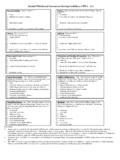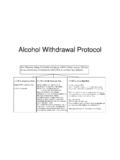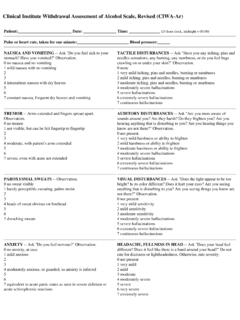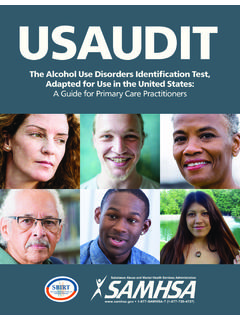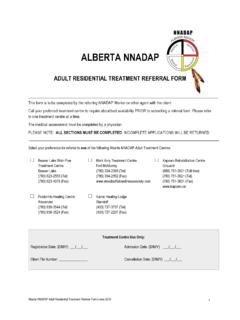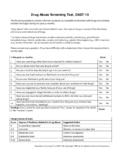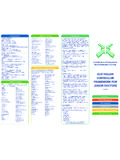Transcription of Alcohol Detoxification - Carolina Behavioral Health
1 Revised March 2009 1 Alcohol Detoxification Clinical Institute withdrawal assessment of Alcohol Scale, Revised (CIWA Ar) Many qualification instruments have been developed for monitoring Alcohol withdrawal (Guthrie, 1989; Sullivan et al., 1989; Sellers & Naranjo, 1983). No single instrument is significantly superior to others. What is clear is that there are significant clinical advantages to quantifying the Alcohol withdrawal syndrome. Quantification is key to preventing excess morbidity and mortality in a group of patients who are at risk for Alcohol withdrawal .
2 Such instruments help clinical personnel recognize the process of withdrawal before it progresses to more advanced stages, such as delirium tremens. By intervening with appropriate pharmacotherapy in those patients who require it, while sparing the majority of patients whose syndromes do not progress to that point, the clinician can prevent over and under treatment of the Alcohol withdrawal syndrome. Finally, quantifying and monitoring the withdrawal process can modify the treatment regimen modified as needed.
3 The best known and most extensively studied scale is the Clinical Institute withdrawal assessment Alcohol (CIWA A) and a shortened version, the CIWA A revised (CIWA Ar). This scale has well-documented reliability, reproducibility and validity, based on comparison to ratings by expert clinicians (Knott, et al., 1981; Wiehl, et al., 1994; Sullivan, et al., 1989). From 30 signs and symptoms, the scale has been carefully refined to a list of 10 signs and symptoms in the CIWA Ar (Wiehl, et al.)
4 , 1994). It is thus easy to use and has been shown to be feasible to use in a variety of clinical settings, including Detoxification units (Naranjo, et al., 1983; Hoey, et al., 1994), psychiatry units (Heinala, et al., 1990), and general medical/surgical wards (Young, et al., 1987; Katta, 1991). The CIWA Ar has added usefulness because high scores, in addition to indicating severe withdrawal , are also predictive of the development of seizures and delirium (Naranjo, et al., 1983; Young, et al.
5 , 1987). Copied from: ASAM Patient Placement Criteria, Second Edition - Revised Revised March 2009 2 CLINICAL PRACTICE GUIDELINES: Alcohol Detoxification Clinical Institute withdrawal assessment of Alcohol Scale, Revised (CIWA - Ar) What it Measures: The CIWA Ar can measure 10 symptoms. Scores of less than 8 to 10 indicate minimal to mild withdrawal . Scores of 8 to 15 indicate moderate withdrawal (marked autonomic arousal); and scores of 15 or more indicate severe withdrawal . The assessment requires 2 minutes to perform (Sullivan, et al, 1989).
6 CIWA Ar categories, with the range of scores in each category, are as follows: Agitation (0 7) Anxiety (0 7) Auditory Disturbances (0 7) Clouding of Sensorium (0 4) Headache (0 7) Nausea/Vomiting (0 7) Paroxysmal Sweats (0 7)
7 Tactile Disturbances (0 7) Tremor (0 7) Visual Disturbances (0 7) A study of the revised version of the CIWA predicted that those with a score of >15 were at increased risk for severe Alcohol withdrawal (RR ; 95% confidence interval ) the higher the score the greater the risk. Some patients ( ) still suffered complications, despite low scores, if left untreated (Foy, et al., 1988). EXAMPLE - Alcohol Detoxification PROTOCOL The following is an example of a protocol developed around the use of the CIWA Ar in an Alcohol Detoxification program: 1.
8 CIWA to be completed on admission and q 8 hours for a period of 24 hours. 2. Determine and record blood Alcohol concentration (BAC) by breathalyzer on admission. 3. Vital signs: pulse rate and BP q 4 hours. Call physician if patient has HR > 110mmHg, DBP > 120 mmHg, or SBP > 180 mmHg. 4. Obtain serum glucose, HFP (hepatic function profile), CMEP (comprehensive metabolic panel, CBC w/DIFF and urine for drug screen. 5. Give Thiamine 100 mg IM now, and then Thiamine 100 mg PO bid times 3 days.)
9 6. If CIWA score is > 0 but < 8 and vital signs are stable, no medication is required. Repeat vital signs q 4 hours and the CIWA q 8 hours. (May repeat CIWA and vital signs as needed.) 7. If CIWA is > 8 but < 15, give Lorazepam (Ativan) 2 mg PO/IM and repeat vital signs q 2 hours and the CIWA q 4 hours. 8. If CIWA is >15 or DBP > 110 mmHg, give Lorazepam (Ativan) 2 mg PO/IM q 1 hour until patient has a CIWA of < 15 or DBP < 110 mmHg (CIWA and vital signs checked q 1 hour until patient s CIWA is < 15 and DBP < 110 mmHg.)
10 When CIWA Revised March 2009 3 is between 8 and 15, give Lorazepam (Ativan) 2 mg PO/IM and resume vital signs q 2 hours and the CIWA q 4 hours. 9. CALL MD IF PATIENT REQUIRES > 6 mg OF LORAZEPAM (ATIVAN) IN THREE HOURS. 10. May awaken patient to complete CIWA and vital signs. 11. When CIWA is < 8 for 3 consecutive 8-hour increments, d/c CIWA protocol. Revised March 2009 4 Addiction Research Foundation Clinical Institute withdrawal assessment for Alcohol , Revised (CIWA Ar) Patient: _____ Pulse or heart rate, take for 1 minute: _____ Date: _____ Time: _____ Blood Pressure: _____ Nausea and Vomiting: Ask, Do you feel sick to your stomach?
